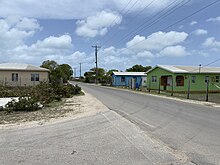
Antigua and Barbuda is a sovereign island country in the Caribbean. It lies at the conjuncture of the Caribbean Sea and the Atlantic Ocean in the Leeward Islands part of the Lesser Antilles.
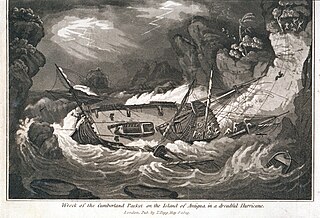
The history of Antigua and Barbuda covers the period from the arrival of the Archaic peoples thousands of years ago to the present day. Prior to European colonization, the lands encompassing present-day Antigua and Barbuda were inhabited by three successive Amerindian societies. The island was claimed by England, who settled the islands in 1632. Under English/British control, the islands witnessed an influx of both Britons and African slaves migrate to the island. In 1981, the islands were granted independence as the modern state of Antigua and Barbuda.
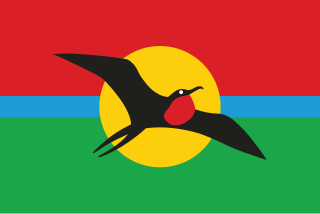
Barbuda is an island located in the eastern Caribbean forming part of the twin-island state of Antigua and Barbuda as an autonomous entity. Barbuda is located approximately 30 miles (48 km) north of Antigua. The sole settlements on the island are Codrington and its surrounding localities. Barbuda is a flat island with the western portion being dominated by Codrington Lagoon, and the eastern portion being dominated by the low-lying Barbuda Highlands, with salty ponds and scrubland spread throughout the island. The climate is classified as tropical marine.
The music of the Lesser Antilles encompasses the music of this chain of small islands making up the eastern and southern portion of the West Indies. Lesser Antillean music is part of the broader category of Caribbean music; much of the folk and popular music is also a part of the Afro-American musical complex, being a mixture of African, European and indigenous American elements. The Lesser Antilles' musical cultures are largely based on the music of African slaves brought by European traders and colonizers. The African musical elements are a hybrid of instruments and styles from numerous West African tribes, while the European slaveholders added their own musics into the mix, as did immigrants from India. In many ways, the Lesser Antilles can be musically divided based on which nation colonized them.
The music of Anguilla is part of the Lesser Antillean music area. The earliest people on the island were the Caribs and Arawaks, who arrived from South America. English settlers from St Kitts and Irish people colonized the island later. Unlike regional neighbors, however, the plantation system of agriculture which relied on chattel slavery never took root in Anguilla, causing a distinctly independent cultural makeup. The most recent influences on Anguilla's musical life come from elsewhere in the Caribbean, especially the music of Trinidad and Tobago and Jamaica, as well as abroad, especially the music of the United States and the United Kingdom. Anguilla's Rastafarian heritage has played a role in the island's music and culture and produced influential figures like activist Ijahnya Christian and Robert Athlyi Rogers, the author of The Holy Piby.
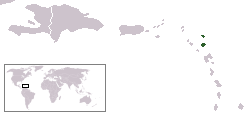
The following is an alphabetical list of topics related to the nation of Antigua and Barbuda.

The music of Antigua and Barbuda is largely African in character, and has only felt a limited influence from European styles due to the population of Antigua and Barbuda descending mostly from West Africans who were made slaves by Europeans.
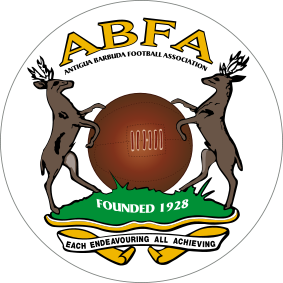
The Antigua and Barbuda national football team is the national team of Antigua and Barbuda, founded in 1928 and is controlled by the Antigua and Barbuda Football Association, a member of the CONCACAF and the Caribbean Football Union (CFU). The team has never qualified for the FIFA World Cup or the CONCACAF Gold Cup.

Antigua, also known as Waladli or Wadadli by the local population, is an island in the Lesser Antilles. It is one of the Leeward Islands in the Caribbean region and the most populous island of the country of Antigua and Barbuda. Antigua and Barbuda became an independent state within the Commonwealth of Nations on 1 November 1981.

The Antiguan Carnival is a celebration of emancipation from slavery, held annually on the island of Antigua. It is a thirteen-day festival of colorful costumes, beauty pageants, talent shows, and music. The festival begins in late July and ends the first Tuesday in August, known as Carnival Tuesday. Both Carnival Monday and Carnival Tuesday are public holidays on the island. Antiguan Carnival replaced the Old Time Christmas Festival in 1957, with hopes of inspiring tourism in Antigua and Barbuda. Some elements of the Old Time Christmas Festival remain in the modern Carnival celebrations.

Benna is a genre of Antiguan and Barbudan music.

The following outline is provided as an overview of and introduction to Antigua and Barbuda:

St. John's Cathedral also known as the St. John the Divine, the Cathedral Church of the Diocese of North Eastern Caribbean and Aruba, is an Anglican church perched on a hilltop in St. John's, Antigua and Barbuda. It is the seat of the Diocese of the North East Caribbean and Aruba in the Church in the Province of the West Indies.
Duckunoo or duckanoo, also referred to as tie-a-leaf, blue drawers (draws), dokonon, and dukunou is a dessert in Jamaica, Antigua and Barbuda, Barbados, French Guiana and some other Lesser Antilles. It is a variation on the dish ducana which originated in Africa. The Caribbean cuisine dish is made from batata, sweet potato, coconut, spices and brown sugar, all tied up in a banana leaf. It is then cooked in boiling water.
The Antigua and Barbuda women's national football team, nicknamed The Benna Girls, is the national women's football team of Antigua and Barbuda and is overseen by the Antigua and Barbuda Football Association, a member of the CONCACAF and the Caribbean Football Union.

Antigua Sailing Week is a week long yacht regatta held in the waters off English Harbour, St Pauls Antigua. It is one of Antigua's most notable events. Founded in 1967, it is cited as one of the top regattas in the world with 100 yachts, 1500 participants and 5000 spectators on average annually. At its heyday, the event attracted an average 150-200 yachts In 2019 the regatta was held between 27 April and 3 May and the 2020 saw the first ever cancellation due to the COVID-19 pandemic. In 2019, 24 countries were represented at the regatta. There are five main races held, including the English Harbour race, and at the end of the week the event finishes with an official prize-giving ceremony presided by the Governor-General.
Royal tours of Antigua and Barbuda by its royal family have been taking place since the 20th century. Elizabeth II, Queen of Antigua and Barbuda, visited the country thrice: 1966, 1977, and 1985.

Fort Berkeley is a historic military fort on the island of Antigua. It is located at the entrance to English Harbour in Saint Paul parish. The fort was built in 1704 and expanded in the mid 18th century. It is part of Nelson's Dockyard National Park and the Antigua Naval Dockyard and Related Archaeological Sites UNESCO World Heritage Site.





